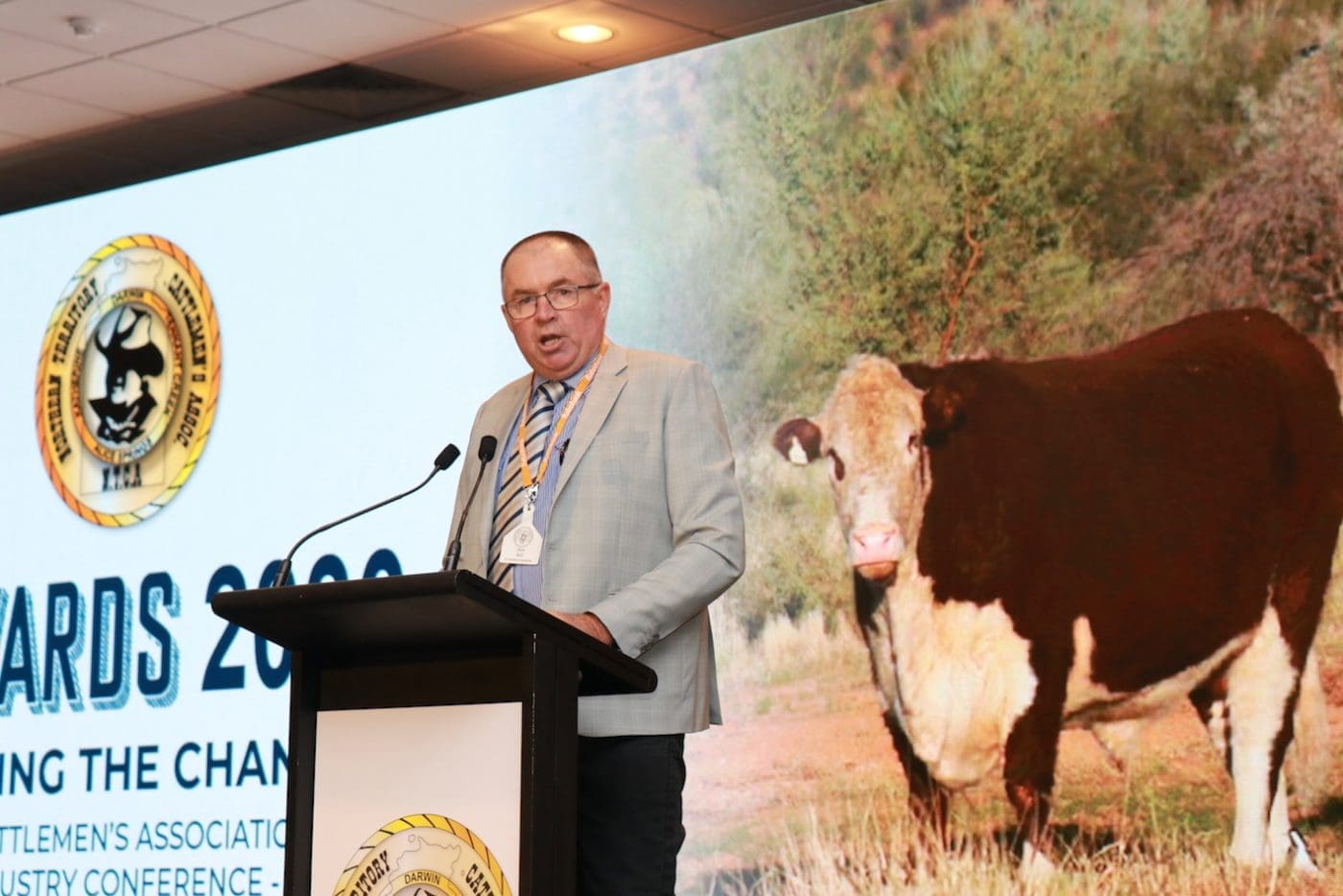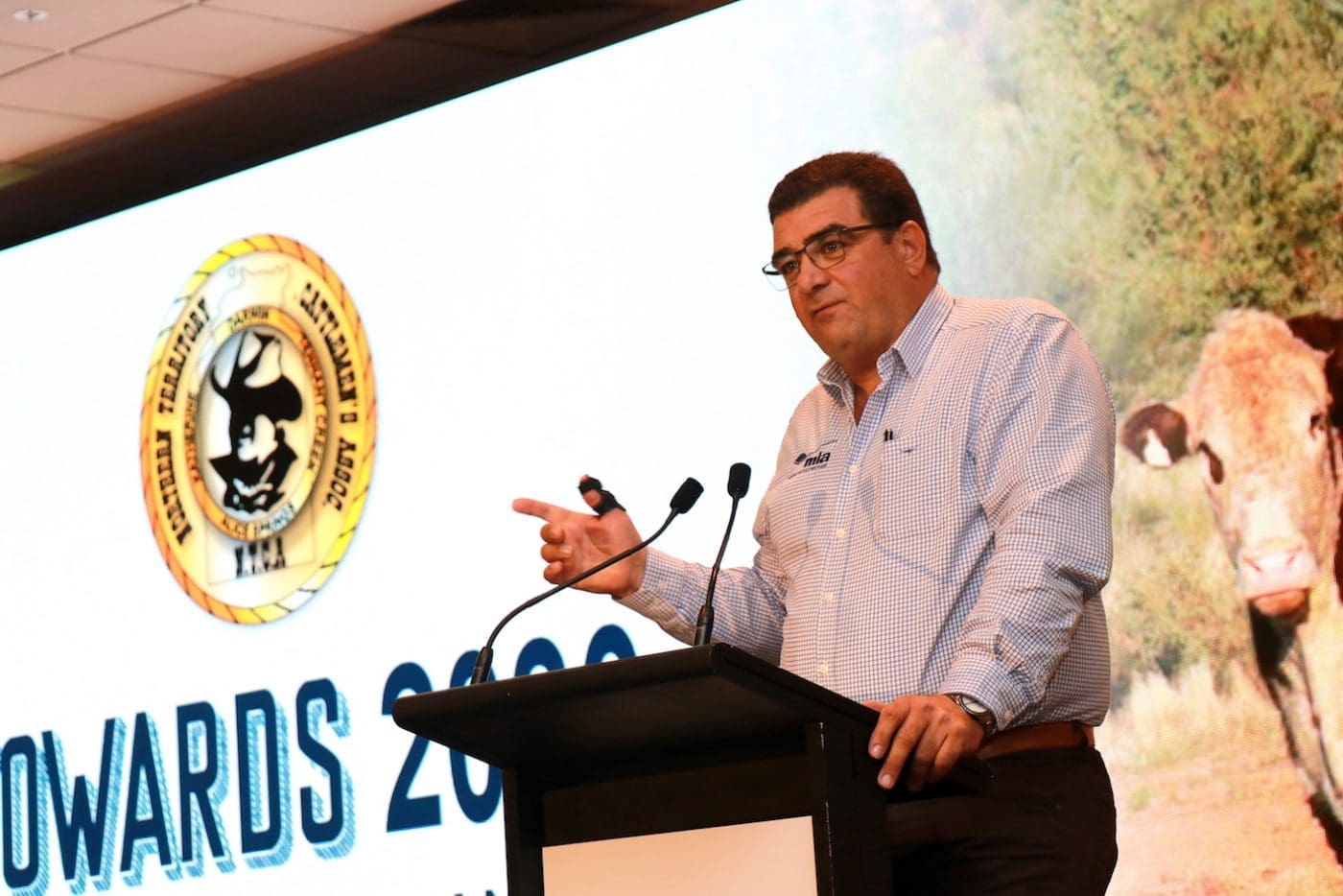FUNDING to give national cattle industry leadership greater clout, resistance to Federal Government live export cost recovery charge hikes, and calls for the industry to collaborate to take full advantage of growing opportunities were key messages in the opening session of this morning’s 36th Northern Territory Cattlemen’s Conference, being held this year at the Alice Springs convention centre.
Tipperary Group of Stations general manager David Connolly was elected as the association’s 14th president at the NTCA AGM yesterday afternoon, and joins new CEO Will Evans in leading the NT cattle industry into the next chapter of its development.
In his outgoing address this morning after having completed his three year term, Alice Springs cattle producer Chris Nott addressed a range of local and national issues, but devoted a large part of his address to making the case for improved funding for Cattle Council of Australia to strengthen its ability to lead and advocate for Australia’s multi billion dollar cattle production sector.
“We have to have the political impact that is needed to protect the future of this industry,” he said.“
“For heaven’s sake the NTCA has seven people, MLA has something like 200, for CCA to operate on five is not going to cut it.”
He suggested the $42 million Red Meat Industry Fund should be dispersed from the control of the Red Meat Advisory Council and given to Peak Industry Councils to develop their own funding models, which could then fund RMAC from their own resources.
‘A million dollars in the bank and half a dozen broken down bores’
He likened the current situation to having a million dollars in the bank and “half a dozen broken down bores”.
“The broken down bores are not going to help with productivity but spending that money to get those bores going will help.
“As the moment the peak industry councils are relying on this drip feed method and that is going nowhere.”
“What is the good of $42m sitting in the bank while PICs are struggling to fund their operations?
“How is that helping producers who rely on Cattle Council of Australia to show leadership, develop policies, set strategic imperatives and advocate on their behalf with the relevant minister.
“The industy needs an adequately and sustainably funded organisation to best represent its interests.”
He added that it was vital that long-awaited work to develop a register of cattle transaction levy payers be completed to allow CCA as the peak industry council to communicate with all grassfed levy payers and bring them to the decision making table – to which MLA managing director Jason Strong later answered that the levy will be up and running by July 1.
Mr Nott also asked the Federal Government to reconsider proposed new cost recovery charges for the live export industry that will bring industry regulatory costs to the vicinity of $100 a head.
“It is important the minister understands these costs have to be paid for and costs to exporters will ultimately come out producers’ pockets.”
He said there had been more than seven reviews into the livestock export industry and more than 150 recommendations for reform in recent years.
“And here’s the kicker – onboard livestock mortalities prior to all these groups and committees being established was just 0.1 percent, and have a guess what, they’re still at 0.1pc.”
Workplace health and safety was a major priority the industry had to improve for the health and safety of its people.
The maximum penalty for industrial manslaughter in the Northern Territory is now life in prison for an individual, and $10 million for a corporate entity.
A recent NTCA survey showing that 20 percent of NT cattle operations do not have a documented Workplace Health and Safety plan showed “we have a lot of work to do”.
He said it was important to recognise the NT cattle industry is in good health with good water and vastly improved stands of grass following a much improved wet season.
Greatest benefits can be achieved by industry committing to ongoing collaboration
MLA managing director Jason Strong emphasised the good news facing the industry, and reinforcing his earlier messages that the industry has entered a three to five year window of exciting opportunities, rarely seen in the past.
Work over decades to build Australia’s global reputation for quality, traceability and food safety, and a diverse range of export markets has come into its own over the past year, which helped the industry to push through the COVID-19 upheaval with minimal disruption compared to other sectors.
He outlined areas in which MLA is investing in research as part of its “fewer, bigger, bolder” policy designed to deliver more consequential impacts from research including the Northern Breeding Business (NB2) project to address calf loss and improve breeder efficiency in northern breeding herds, on-farm pain relief, phosphorous use, cattle tick vaccines and MSA transport efficiency.
But his primary message was that the greatest benefits can be achieved by the industry committing to ongoing collaboration.
“If we work together and understand the collective benefits of a unified supply chain then our path to prosperity knows no bounds.
“This must include adoption of research and sharing of tools, technologies, especially through peer to peer based learning.”
“We have an incredible opportunity in front of us.”
He urged the industry not to listen to the all-too-common voices saying what cannot be done, and look instead at what can be done, concluding with the famous quote from American anthropologist Margaret Mead: “Never doubt that a small group of thoughtful, committed citizens can change the world; indeed, it’s the only thing that ever has.”
Pastoral clearing red tape cut in the NT
At this morning’s conference Northern Territory Minister for Agriculture Nicole Manison announced a new measure to cut red tape for the NT cattle industry which comprises a new and simplified pastoral land clearing application process, which she said will cut the application time frame from six months to six weeks.
Lessees can now apply to clear up to 1000ha of native vegetation per application for non-irrigated purposes.
The simplified process ensures decision-making is proportionate to risk. That is, low risk and unconstrained land will be made more readily available for development through a shortened process.
Applications must meet specific environmental criteria outlined in the Pastoral Land Clearing Guidelines, thereby reducing environmental complexity and enabling an expedited assessment and approvals process.
To support the process, a new application forms, Policy and updated Guidelines have been developed and are available at https://nt.gov.au/property/



You nailed it Chris, well done.
First step is finding a way for Cattle Council of Australia (CCA) to have access to levy payers contact details to enable communication with them.
Second step is finding a way for a portion of the cattle transaction levy to fund CCA’s essential role in representing cattle producers.